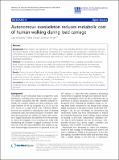| dc.contributor.author | Mooney, Luke M. | |
| dc.contributor.author | Rouse, Elliott J. | |
| dc.contributor.author | Herr, Hugh M | |
| dc.date.accessioned | 2014-06-02T16:38:13Z | |
| dc.date.available | 2014-06-02T16:38:13Z | |
| dc.date.issued | 2014-05 | |
| dc.date.submitted | 2014-02 | |
| dc.identifier.issn | 1743-0003 | |
| dc.identifier.uri | http://hdl.handle.net/1721.1/87603 | |
| dc.description.abstract | Background: Many soldiers are expected to carry heavy loads over extended distances, often resulting in physical and mental fatigue. In this study, the design and testing of an autonomous leg exoskeleton is presented. The aim of the device is to reduce the energetic cost of loaded walking. In addition, we present the Augmentation Factor, a general framework of exoskeletal performance that unifies our results with the varying abilities of previously developed exoskeletons.
Methods:
We developed an autonomous battery powered exoskeleton that is capable of providing substantial levels of positive mechanical power to the ankle during the push-off region of stance phase. We measured the metabolic energy consumption of seven subjects walking on a level treadmill at 1.5 m/s, while wearing a 23 kg vest.
Results:
During the push-off portion of the stance phase, the exoskeleton applied positive mechanical power with an average across the gait cycle equal to 23 ± 2 W (11.5 W per ankle). Use of the autonomous leg exoskeleton significantly reduced the metabolic cost of walking by 36 ± 12 W, which was an improvement of 8 ± 3% (p = 0.025) relative to the control condition of not wearing the exoskeleton.
Conclusions:
In the design of leg exoskeletons, the results of this study highlight the importance of minimizing exoskeletal power dissipation and added limb mass, while providing substantial positive power during the walking gait cycle. | en_US |
| dc.description.sponsorship | National Science Foundation (U.S.) (Graduate Research Fellowship award number 1122374) | en_US |
| dc.description.sponsorship | United States. National Aeronautics and Space Administration (NASA award number NNX12AR09G) | en_US |
| dc.description.sponsorship | United States. Dept. of Defense (Award number 119–000245) | en_US |
| dc.publisher | BioMed Central Ltd | en_US |
| dc.relation.isversionof | http://dx.doi.org/10.1186/1743-0003-11-80 | en_US |
| dc.rights | Creative Commons Attribution | en_US |
| dc.rights.uri | http://creativecommons.org/licenses/by/4.0 | en_US |
| dc.source | BioMed Central Ltd | en_US |
| dc.title | Autonomous exoskeleton reduces metabolic cost of human walking during load carriage | en_US |
| dc.type | Article | en_US |
| dc.identifier.citation | Mooney, Luke M., Elliott J. Rouse, and Hugh M. Herr. "Autonomous exoskeleton reduces metabolic cost of human walking during load carriage." Journal of NeuroEngineering and Rehabilitation (2014) 11:80. | en_US |
| dc.contributor.department | Harvard University--MIT Division of Health Sciences and Technology | en_US |
| dc.contributor.department | Massachusetts Institute of Technology. Department of Mechanical Engineering | en_US |
| dc.contributor.department | Program in Media Arts and Sciences (Massachusetts Institute of Technology) | en_US |
| dc.contributor.mitauthor | Mooney, Luke M. | en_US |
| dc.contributor.mitauthor | Rouse, Elliott Jay | en_US |
| dc.contributor.mitauthor | Herr, Hugh M. | en_US |
| dc.relation.journal | Journal of NeuroEngineering and Rehabilitation | en_US |
| dc.eprint.version | Final published version | en_US |
| dc.type.uri | http://purl.org/eprint/type/JournalArticle | en_US |
| eprint.status | http://purl.org/eprint/status/PeerReviewed | en_US |
| dc.date.updated | 2014-05-28T11:35:30Z | |
| dc.language.rfc3066 | en | |
| dc.rights.holder | Luke M Mooney et al.; licensee BioMed Central Ltd. | |
| dspace.orderedauthors | Mooney, Luke M; Rouse, Elliott J; Herr, Hugh M | en_US |
| dc.identifier.orcid | https://orcid.org/0000-0003-1516-0093 | |
| dc.identifier.orcid | https://orcid.org/0000-0003-3169-1011 | |
| mit.license | PUBLISHER_CC | en_US |
| mit.metadata.status | Complete | |
